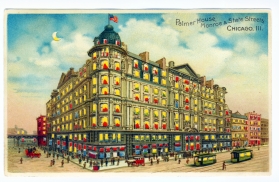 Once I held up a Hold to Light postcard to the 300 watt light bulb the dealer had lighting his counter, I was mesmerized and I had to buy it no matter the cost. Luckily the antique dealer didn’t have many postcards and really didn’t value the HTL postcard correctly. I purchased it for $14.00 in the late 70’s.
Once I held up a Hold to Light postcard to the 300 watt light bulb the dealer had lighting his counter, I was mesmerized and I had to buy it no matter the cost. Luckily the antique dealer didn’t have many postcards and really didn’t value the HTL postcard correctly. I purchased it for $14.00 in the late 70’s.
Below is an explanation of the different types of Hold to Light postcards and some history about J. Koehler.
Hold to Light (HTL): when held up to a strong light, the moon, water ripples, windows, vehicles and other objects light up brilliantly. Hold to Light postcards are of three distinct types:
- Die Cut Postcards are triple layered cards on which certain parts of the topmost layer have been cut out, a middle layer with thin colored tissue paper and a bottom layer for the Address backing. When held up to a strong light, such as a lamp, the cut out portions appear brightly colored and illuminated. These cards generally highlight windows, the moon, flowers, or other small discrete cut-out areas.
- Transparency Postcards are more sophisticated. Also made of three or more layers, these have a 'hidden design' which is usually related to the front design. Objects, characters, colors, or scenes appear magically when the postcard is held in front of a strong light. These cards are classified in four groups:
- Day into night scenes.
- The color changes (usually from black and white to colors).
- A new image appears (which may or may not be related to the front image).
- A partial image appears or changes
- Slide Transparency Postcards are, as the name implies, a slide transparency sandwiched between two layers of a postcard. These are rare and hard to find.
Joseph Koehler, New York, NY; Founded as a printing firm 1892-1911, they later began publishing view-cards in both continuous tone and halftone lithography as well as real photo cards. They have been well known for their early hold to light postcards, mechanicals, and exposition cards, since publishing an unofficial postcard set of the 1893 World's Columbian Exposition in Chicago. While most companies stopped using the expensive chromolithographic printing method in favor of the cheaper halftone printing process, Koehler (a pioneer in halftone technology) had returned to producing chromolithographs. Koehler postcards have a very distinct style to them and is the reason why Koehler postcards are so sought after by serious collectors. All of their postcards were printed in Berlin Germany.
posted by Neil Jan Gale, Director, Chicago Postcard Museum